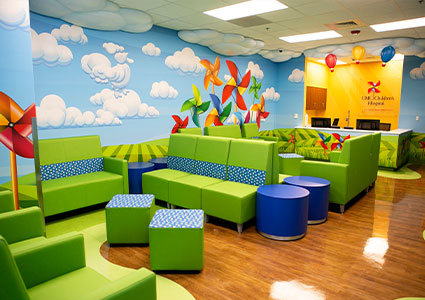How Starnet is preparing its members for incoming technological revolutions
Starnet Worldwide Commercial Flooring Partnership (Starnet) was officially formed in 1992, but its roots go back further. President and CEO, Mark Bischoff, outlines the company’s history: “Starnet started as a group of members with a couple of manufacturers that wanted to get together to share best practices and have some fun. They would go on networking trips together, as an informal organization and operated this as Comspec through the 1980s. Then it became a formal organization called IMG-International Marketing Group, which began to develop products and draft formal agreements with supporting manufacturers. It was owned by three industry veterans, and they grew it to the point where they felt for the organization to succeed it needed to be owned by its members. The organization then adjusted its structure to form a legal cooperative. All the members benefit from the dividend generated by the goods and services they direct to supporting vendors and are also able to share the benefits of networking and knowledge sharing with their peers. In 1992 this was formalized, and the name was changed to Starnet.”
 Mark goes on to describe the range of products and services its network provides: “The members are primarily focused on commercial floor coverings in the major segments of workplace, education, healthcare, hospitality, and retail. So that’s every part of commercial floor covering, including wood, ceramic, resilient and carpet. They execute broad loom as well as carpet tile. They also install all types of resilient flooring. Some of them do terrazzo and site applied poured floors of various kinds including epoxy and polished concrete. All our members also offer additional services. Often, they’re deeply involved with the metro areas they’re covering beyond pure commercial and provide services for very large mixed use and residential multifamily properties. The first few floors might be retail and office space, and then above that are residential condos or something similar. Our members in those metro areas will often fit the interiors for the entire building for their favored developer clients. Some of them also operate in the sports sector, so they lay synthetic turf and running tracks, supported with added specialty services.
Mark goes on to describe the range of products and services its network provides: “The members are primarily focused on commercial floor coverings in the major segments of workplace, education, healthcare, hospitality, and retail. So that’s every part of commercial floor covering, including wood, ceramic, resilient and carpet. They execute broad loom as well as carpet tile. They also install all types of resilient flooring. Some of them do terrazzo and site applied poured floors of various kinds including epoxy and polished concrete. All our members also offer additional services. Often, they’re deeply involved with the metro areas they’re covering beyond pure commercial and provide services for very large mixed use and residential multifamily properties. The first few floors might be retail and office space, and then above that are residential condos or something similar. Our members in those metro areas will often fit the interiors for the entire building for their favored developer clients. Some of them also operate in the sports sector, so they lay synthetic turf and running tracks, supported with added specialty services.
“Beyond flooring, a lot of the members delivering services for the sports sector will work on locker rooms, fitting protective padding and acoustic treatments as required. Some of the members are affiliated with commercial office furniture companies, so they might operate on a two-third office furniture, one-third commercial flooring basis. We have several members who follow this model.”
Networking opportunities
Mark then sheds light on the specific benefits Starnet’s members experience: “Firstly, there’s the dividend through the manufacturers that support Starnet. When our members purchase products, the manufacturer pays an incentive which we collect throughout the year and then pay out to them as a lump sum based on their branch level support of each manufacturer.
“Secondary benefits include two annual events: the spring and fall shareholder meetings. The spring meetings are mandatory, and all members benefit from a full program of events to help improve their businesses and strengthen the connection between the manufacturers and members at the executive level. We often invite a keynote public speaker to review economics, architecture and design. We also organize networking and knowledge sharing events, with workshops around specific topics such as technology or installation to help our members be better owners and operators.
“When we complete the follow-up surveys, the number one positive that our members take away from our annual gatherings is being with other members who operate in different markets outside their own. Getting together to discuss business is a huge benefit, and our members tell us how much they get out of networking and learning about the industry beyond their local market or operating model.
“We also have an online distance learning tool called Starnet University where we develop topics ourselves. Alongside this we also work with our manufacturers to

host webinars or develop workshops and training resources for other members so that people who can’t make it to the live meeting can still benefit. In addition, we have a separate division called Starnet Floor Care. The Floor Care group manages millions of square feet of space over the year. Most of the Starnet Floor Care group are also members of the product and installation cohort. We line up manufacturer support, they review and audit our processes, equipment, and our chemistry and they approve the approach of our Starnet Floor Care members. That’s a validation of their technical capability and demonstrates that the manufacturers trust them to offer that post installation service.
“Beyond that, we also run a full committee system, so our day-to-day focus really falls to the members through the committees across the US and Canada. These committees meet generally every month and feed initiatives up to the board. The board will then either expand those initiatives or they’ll add to them from their own direction. The board members are made-up of a mix of members of different sizes, we try to keep a good mix of board members from across the membership.”
Technology and data
A further benefit for members of Starnet is the way in which the organization helps prepare its members for the future. Mark expands: “In global commercial real estate you can see a real focus on technology. It’s a part of the wave of AI dealmaking that is transforming many industries. There are some significant changes coming to real estate in the near future that will impact our members. We are preparing them for that so they can stay ahead of the curve. These technologies and data models aren’t vital for the success of our members today, but in a few years, they will be. We provide consistent communication and coaching, covering what steps our members can take to make sure they are fully prepared.
“We feel commercial real estate ownership is going to be democratized in the same way that residential real estate was democratized and tokenized by Airbnb. Commercial real estate, although it’s a huge industry, is held by very few people for the most part. The tokenization of commercial real estate is going to allow normal people to get involved in the same way that people began with Airbnb businesses, purchasing and monetizing property globally online. These changes also represent enormous opportunity for the industry. Without sufficient technology and data models though, you’re not going to be able to participate. The closest analogy is one from retail. If you consider the barcode for example. If you try to be a retailer and you refuse to incorporate barcodes, you would be significantly limiting your ability to succeed.”
